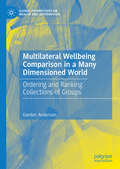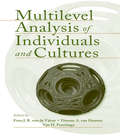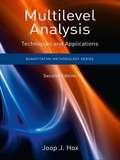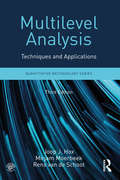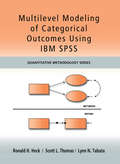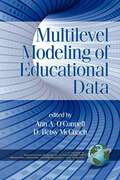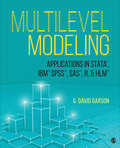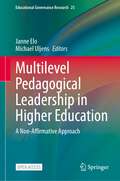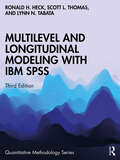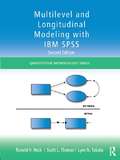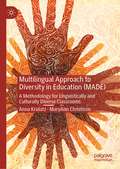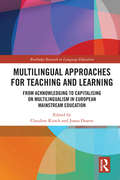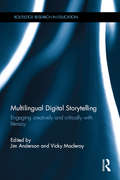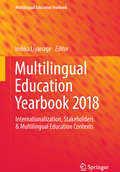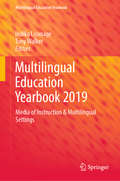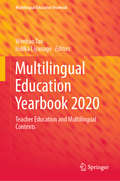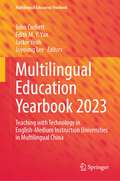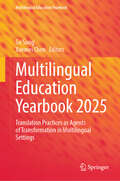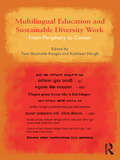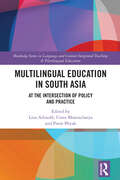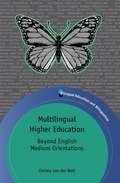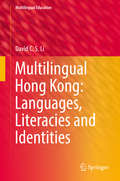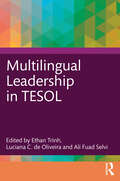- Table View
- List View
Multilateral Wellbeing Comparison in a Many Dimensioned World: Ordering and Ranking Collections of Groups (Global Perspectives on Wealth and Distribution)
by Gordon AndersonThis book addresses the disparities that arise when measuring and modeling societal behavior and progress across the social sciences. It looks at why and how different disciplines and even researchers can use the same data and yet come to different conclusions about equality of opportunity, economic and social mobility, poverty and polarization, and conflict and segregation. Because societal behavior and progress exist only in the context of other key aspects, modeling becomes exponentially more complex as more of these aspects are factored into considerations. The content of this book transcends disciplinary boundaries, providing valuable information on measuring and modeling to economists, sociologists, and political scientists who are interested in data-based analysis of pressing social issues.
Multilevel Analysis of Individuals and Cultures
by Ype H. Poortinga Fons J.R. van de Vijver Dianne A. Van HemertIn this book, top specialists address theoretical, methodological, and empirical multilevel models as they relate to the analysis of individual and cultural data. Divided into four parts, the book opens with the basic conceptual and theoretical issues in multilevel research, including the fallacies of such research. Part II describes the methodological aspects of multilevel research, including data-analytic and structural equation modeling techniques. Applications and models from various research areas including control, values, organizational behavior, social beliefs, well-being, personality, response styles, school performance, family, and acculturation, are explored in Part III. This section also deals with validity issues in aggregation models. The book concludes with an overview of the kinds of questions addressed in multilevel models and highlights the theoretical and methodological issues yet to be explored. This book is intended for researchers and advanced students in psychology, sociology, social work, marriage and family therapy, public health, anthropology, education, economics, political science, and cultural and ethnic studies who study the relationship between behavior and culture.
Multilevel Analysis: Techniques and Applications, Second Edition
by Joop J. Hox Rens van de Schoot Mirjam MoerbeekThis practical introduction helps readers apply multilevel techniques to their research. Noted as an accessible introduction, the book also includes advanced extensions, making it useful as both an introduction and as a reference to students, researchers, and methodologists. Basic models and examples are discussed in non-technical terms with an emphasis on understanding the methodological and statistical issues involved in using these models. The estimation and interpretation of multilevel models is demonstrated using realistic examples from various disciplines. For example, readers will find data sets on stress in hospitals, GPA scores, survey responses, street safety, epilepsy, divorce, and sociometric scores, to name a few. The data sets are available on the website in SPSS, HLM, MLwiN, LISREL and/or Mplus files. Readers are introduced to both the multilevel regression model and multilevel structural models. Highlights of the second edition include: Two new chapters--one on multilevel models for ordinal and count data (Ch. 7) and another on multilevel survival analysis (Ch. 8). Thoroughly updated chapters on multilevel structural equation modeling that reflect the enormous technical progress of the last few years. The addition of some simpler examples to help the novice, whilst the more complex examples that combine more than one problem have been retained. A new section on multivariate meta-analysis (Ch. 11). Expanded discussions of covariance structures across time and analyzing longitudinal data where no trend is expected. Expanded chapter on the logistic model for dichotomous data and proportions with new estimation methods. An updated website at http://www.joophox.net/ with data sets for all the text examples and up-to-date screen shots and PowerPoint slides for instructors. Ideal for introductory courses on multilevel modeling and/or ones that introduce this topic in some detail taught in a variety of disciplines including: psychology, education, sociology, the health sciences, and business. The advanced extensions also make this a favorite resource for researchers and methodologists in these disciplines. A basic understanding of ANOVA and multiple regression is assumed. The section on multilevel structural equation models assumes a basic understanding of SEM.
Multilevel Analysis: Techniques and Applications, Third Edition (Quantitative Methodology Series )
by Joop J. Hox Rens van de Schoot Mirjam MoerbeekApplauded for its clarity, this accessible introduction helps readers apply multilevel techniques to their research. The book also includes advanced extensions, making it useful as both an introduction for students and as a reference for researchers. Basic models and examples are discussed in nontechnical terms with an emphasis on understanding the methodological and statistical issues involved in using these models. The estimation and interpretation of multilevel models is demonstrated using realistic examples from various disciplines including psychology, education, public health, and sociology. Readers are introduced to a general framework on multilevel modeling which covers both observed and latent variables in the same model, while most other books focus on observed variables. In addition, Bayesian estimation is introduced and applied using accessible software.
Multilevel Modeling of Categorical Outcomes Using IBM SPSS: Multilevel Modeling Of Categorical Outcomes Using Ibm Spss (Quantitative Methodology Series)
by Scott Thomas Ronald H Heck Lynn TabataThis is the first workbook that introduces the multilevel approach to modeling with categorical outcomes using IBM SPSS Version 20. Readers learn how to develop, estimate, and interpret multilevel models with categorical outcomes. The authors walk readers through data management, diagnostic tools, model conceptualization, and model specification issues related to single-level and multilevel models with categorical outcomes. Screen shots clearly demonstrate techniques and navigation of the program. Modeling syntax is provided in the appendix. Examples of various types of categorical outcomes demonstrate how to set up each model and interpret the output. Extended examples illustrate the logic of model development, interpretation of output, the context of the research questions, and the steps around which the analyses are structured. Readers can replicate examples in each chapter by using the corresponding data and syntax files available at www.psypress.com/9781848729568. The book opens with a review of multilevel with categorical outcomes, followed by a chapter on IBM SPSS data management techniques to facilitate working with multilevel and longitudinal data sets. Chapters 3 and 4 detail the basics of the single-level and multilevel generalized linear model for various types of categorical outcomes. These chapters review underlying concepts to assist with trouble-shooting common programming and modeling problems. Next population-average and unit-specific longitudinal models for investigating individual or organizational developmental processes are developed. Chapter 6 focuses on single- and multilevel models using multinomial and ordinal data followed by a chapter on models for count data. The book concludes with additional trouble shooting techniques and tips for expanding on the modeling techniques introduced. Ideal as a supplement for graduate level courses and/or professional workshops on multilevel, longitudinal, latent variable modeling, multivariate statistics, and/or advanced quantitative techniques taught in psychology, business, education, health, and sociology, this practical workbook also appeals to researchers in these fields. An excellent follow up to the authors’ highly successful Multilevel and Longitudinal Modeling with IBM SPSS and Introduction to Multilevel Modeling Techniques, 2nd Edition, this book can also be used with any multilevel and/or longitudinal book or as a stand-alone text introducing multilevel modeling with categorical outcomes.
Multilevel Modeling of Educational Data (Quantitative Methods in Education and the Behavioral Sciences Series)
by D. Betsy McCoach Ann A. O'ConnellMultilevel Modeling of Educational Data, co-edited by Ann A. O’Connell, Ed.D., and D. Betsy McCoach, Ph.D., is the next volume in the series: Quantitative Methods in Education and the Behavioral Sciences: Issues, Research and Teaching (Information Age Publishing), sponsored by the Educational Statisticians' Special Interest Group (Ed-Stat SIG) of the American Educational Research Association. <p><p>The use of multilevel analyses to examine effects of groups or contexts on individual outcomes has burgeoned over the past few decades. Multilevel modeling techniques allow educational researchers to more appropriately model data that occur within multiple hierarchies (i.e.- the classroom, the school, and/or the district). Examples of multilevel research problems involving schools include establishing trajectories of academic achievement for children within diverse classrooms or schools or studying school-level characteristics on the incidence of bullying. <p><p>Multilevel models provide an improvement over traditional single-level approaches to working with clustered or hierarchical data; however, multilevel data present complex and interesting methodological challenges for the applied education research community.
Multilevel Modeling: Applications in STATA®, IBM® SPSS®, SAS®, R, & HLM™
by Professor George David GarsonMultilevel Modeling: Applications in STATA®, IBM® SPSS®, SAS®, R & HLM™ provides a gentle, hands-on illustration of the most common types of multilevel modeling software, offering instructors multiple software resources for their students and an applications-based foundation for teaching multilevel modeling in the social sciences. Author G. David Garson’s step-by-step instructions for the software walk readers through each package. The instructions for the different platforms allow students to get a running start using the package with which they are most familiar while the instructor can start teaching the concepts of multilevel modeling right away. Instructors will find this text serves as both a comprehensive resource for their students and a foundation for their teaching alike.
Multilevel Modeling: Applications in STATA®, IBM® SPSS®, SAS®, R, & HLM™
by Professor George David GarsonMultilevel Modeling: Applications in STATA®, IBM® SPSS®, SAS®, R & HLM™ provides a gentle, hands-on illustration of the most common types of multilevel modeling software, offering instructors multiple software resources for their students and an applications-based foundation for teaching multilevel modeling in the social sciences. Author G. David Garson’s step-by-step instructions for the software walk readers through each package. The instructions for the different platforms allow students to get a running start using the package with which they are most familiar while the instructor can start teaching the concepts of multilevel modeling right away. Instructors will find this text serves as both a comprehensive resource for their students and a foundation for their teaching alike.
Multilevel Pedagogical Leadership in Higher Education: A Non-Affirmative Approach (Educational Governance Research #25)
by Michael Uljens Janne EloThis Open Access book addresses the theoretical grounding of the pedagogical dimensions of higher education leadership and its empirical study. The book’s general point of departure is that educational leadership is a multi-level phenomenon, operating as policy work on a transnational and national level, as educational leadership on various organizational levels, and as supervision and teaching on an interactional level. It is in and through these discursive practices that policies are initiated, interpreted, translated and enacted. The volume demonstrates how Non Affirmative Theory (NAT) of education applies to understanding and dealing with the pedagogical dimensions of the multi-level and multi-actor phenomena of HE leadership in a coherent manner. It allows one to explore how the pedagogical scope of action at each level of leadership is framed or staged by the other levels, as well as how actors at different levels utilise their scope. The book starts out by exploring the pedagogical aspects of HE leadership as a multi-level and multi-actor phenomenon at a theoretical level. It continues to discuss nation state HE in a global perspective, and HE leadership in an organisational perspective. Next, the book looks at departmental leadership, management and development. Parallel with this, the volume critically explores the non-affirmative position itself by a contrasting dialogue with other theoretical approaches.
Multilevel and Longitudinal Modeling with IBM SPSS (Quantitative Methodology Series)
by Ronald H. Heck Scott L. Thomas Lynn N. TabataMultilevel and Longitudinal Modeling with IBM SPSS, Third Edition, demonstrates how to use the multilevel and longitudinal modeling techniques available in IBM SPSS Versions 25-27. Annotated screenshots with all relevant output provide readers with a step-by-step understanding of each technique as they are shown how to navigate the program. Throughout, diagnostic tools, data management issues, and related graphics are introduced. SPSS commands show the flow of the menu structure and how to facilitate model building, while annotated syntax is also available for those who prefer this approach. Extended examples illustrating the logic of model development and evaluation are included throughout the book, demonstrating the context and rationale of the research questions and the steps around which the analyses are structured. The book opens with the conceptual and methodological issues associated with multilevel and longitudinal modeling, followed by a discussion of SPSS data management techniques that facilitate working with multilevel, longitudinal, or cross-classified data sets. The next few chapters introduce the basics of multilevel modeling, developing a multilevel model, extensions of the basic two-level model (e.g., three-level models, models for binary and ordinal outcomes), and troubleshooting techniques for everyday-use programming and modeling problems along with potential solutions. Models for investigating individual and organizational change are next developed, followed by models with multivariate outcomes and, finally, models with cross-classified and multiple membership data structures. The book concludes with thoughts about ways to expand on the various multilevel and longitudinal modeling techniques introduced and issues (e.g., missing data, sample weights) to keep in mind in conducting multilevel analyses. Key features of the third edition: Thoroughly updated throughout to reflect IBM SPSS Versions 26-27. Introduction to fixed-effects regression for examining change over time where random-effects modeling may not be an optimal choice. Additional treatment of key topics specifically aligned with multilevel modeling (e.g., models with binary and ordinal outcomes). Expanded coverage of models with cross-classified and multiple membership data structures. Added discussion on model checking for improvement (e.g., examining residuals, locating outliers). Further discussion of alternatives for dealing with missing data and the use of sample weights within multilevel data structures. Supported by online data sets, the book's practical approach makes it an essential text for graduate-level courses on multilevel, longitudinal, latent variable modeling, multivariate statistics, or advanced quantitative techniques taught in departments of business, education, health, psychology, and sociology. The book will also prove appealing to researchers in these fields. The book is designed to provide an excellent supplement to Heck and Thomas's An Introduction to Multilevel Modeling Techniques, Fourth Edition; however, it can also be used with any multilevel or longitudinal modeling book or as a stand-alone text.
Multilevel and Longitudinal Modeling with IBM SPSS: Multilevel And Longitudinal Modeling With Ibm Spss (Quantitative Methodology Series)
by Ronald H. Heck Scott L. Thomas Lynn N. TabataThis book demonstrates how to use multilevel and longitudinal modeling techniques available in the IBM SPSS mixed-effects program (MIXED). Annotated screen shots provide readers with a step-by-step understanding of each technique and navigating the program. Readers learn how to set up, run, and interpret a variety of models. Diagnostic tools, data management issues, and related graphics are introduced throughout. Annotated syntax is also available for those who prefer this approach. Extended examples illustrate the logic of model development to show readers the rationale of the research questions and the steps around which the analyses are structured. The data used in the text and syntax examples are available at www.routledge.com/9780415817110. Highlights of the new edition include: Updated throughout to reflect IBM SPSS Version 21. Further coverage of growth trajectories, coding time-related variables, covariance structures, individual change and longitudinal experimental designs (Ch.5). Extended discussion of other types of research designs for examining change (e.g., regression discontinuity, quasi-experimental) over time (Ch.6). New examples specifying multiple latent constructs and parallel growth processes (Ch. 7). Discussion of alternatives for dealing with missing data and the use of sample weights within multilevel data structures (Ch.1). The book opens with the conceptual and methodological issues associated with multilevel and longitudinal modeling, followed by a discussion of SPSS data management techniques which facilitate working with multilevel, longitudinal, and cross-classified data sets. Chapters 3 and 4 introduce the basics of multilevel modeling: developing a multilevel model, interpreting output, and trouble-shooting common programming and modeling problems. Models for investigating individual and organizational change are presented in chapters 5 and 6, followed by models with multivariate outcomes in chapter 7. Chapter 8 provides an illustration of multilevel models with cross-classified data structures. The book concludes with ways to expand on the various multilevel and longitudinal modeling techniques and issues when conducting multilevel analyses. Ideal as a supplementary text for graduate courses on multilevel and longitudinal modeling, multivariate statistics, and research design taught in education, psychology, business, and sociology, this book’s practical approach also appeals to researchers in these fields. The book provides an excellent supplement to Heck & Thomas’s An Introduction to Multilevel Modeling Techniques, 2nd Edition; however, it can also be used with any multilevel and/or longitudinal modeling book or as a stand-alone text.
Multilingual Approach to Diversity in Education (MADE): A Methodology for Linguistically and Culturally Diverse Classrooms
by MaryAnn Christison Anna KrulatzThis book introduces the Multilingual Approach to Diversity in Education (MADE), a framework that provides an extensive, holistic instrument with research-based teacher indicators for teachers, teacher educators, and administrators to deliver optimal education to multilingual learners in a range of contexts. The authors introduce and provide a theoretical and research-based rationale for the MADE, presenting in turn each of its seven indicators, situating them within current research and theory in multilingualism and education, and providing specific examples of classroom applications. This book will be of interest to academics, teacher educators, pre-service and practicing teachers, and graduate students interested in teaching and researching multilingual learners.
Multilingual Approaches for Teaching and Learning: From Acknowledging to Capitalising on Multilingualism in European Mainstream Education (Routledge Research in Language Education)
by Claudine Kirsch Joana DuarteMultilingual Approaches for Teaching and Learning outlines the opportunities and challenges of multilingual approaches in mainstream education in Europe. The book, which draws on research findings from several officially monolingual, bilingual, and multilingual countries in Europe, discusses approaches to multilingual education which capitalise on students’ multilingual resources from early childhood to higher education. This book synthesises research on multilingual education, relates theory to practice, and discusses different pedagogical approaches from diverse perspectives. The first section of the book outlines multilingual approaches in early childhood education and primary school, the second looks at multilingual approaches in secondary school and higher education, and the third examines the influence of parents, policy-makers, and professional development on the implementation and sustainability of multilingual approaches. The book demonstrates that educators can leverage students’ multilingualism to promote learning and help students achieve their full potential. This book will be of great interest to academics, researchers, and postgraduate students in the fields of language education, psychology, sociolinguistics, and applied linguistics.
Multilingual Digital Storytelling: Engaging creatively and critically with literacy (Routledge Research in Education)
by Jim Anderson Vicky MacleroyClassrooms are increasingly multicultural in their social composition, and students are increasingly connected, through digital media, to local and global networks. However, pedagogy has failed to take full advantage of the opportunities these resources represent. Multilingual Digital Storytelling draws attention to the interfaces between learner engagement, creativity and critical digital literacy, as well as addressing the multilingual within the multiliteracies framework. Addressing a significant gap in the field of multiliteracies by focusing on multilingualism, this book explores new digital spaces for language learning and methods of extending understandings of youth literacy in an increasingly interconnected world. Drawing on innovative and multi-site research projects based in mainstream and community schools in London and overseas, this book discusses how young people become engaged creatively and critically with literacy by demonstrating how digital storytelling can be used as a tool for language development. The book begins by considering linguistic, cultural, cognitive and social dimensions of language learning from a theoretical perspective, whilst the second part focuses on practical case studies that reflect and illustrate these theoretical principles. Offering a powerful new perspective on multiliteracies pedagogy, Multilingual Digital Storytelling will appeal to researchers and academics in the fields of education, applied linguistics, sociology and youth and community studies. It will also be an invaluable resource for teachers, teacher educators, curriculum planners and policymakers.
Multilingual Education Yearbook 2018: Internationalization, Stakeholders And Multilingual Education Contexts (Multilingual Education Yearbook Ser.)
by Indika LiyanageThis volume examines how internationalization, stakeholders, and educational contexts have a reciprocal influence on multilinguals and their communities both as individual and collective variables. Therefore, the exploration of these variables and how they intersect and interact with worldwide phenomena like globalization, global citizenship, and responsive and responsible provisions of education are the central foci of this volume. Contributors from different parts of the world draw on analyses of various forms of data to foreground these foci with implications for effective multilingual education practices in their contexts, and beyond.The Multilingual Education Yearbook publishes high-quality empirical research on education in multilingual societies. It publishes research findings that, in addition to providing descriptions of language learning, development and use in language contact and multilingual contexts, will shape language education policy and practices in multilingual societies.
Multilingual Education Yearbook 2019: Media of Instruction & Multilingual Settings (Multilingual Education Yearbook)
by Indika Liyanage Tony WalkerThis book offers essential insights into the challenges and complexities surrounding the medium of instruction (MOI), its impact on all languages and stakeholders in multilingual contexts, educational processes, developments and outcomes. MOI has been a prominent topic in recent debates on the role of languages in education in multilingual contexts, partly because prioritizing one language over others as the medium of instruction has a profound impact on all languages and stakeholders in multilingual contexts. These include, to name but a few, (language) teachers, teacher educators, students, and policymakers, as well as industries and enterprises built around the needs and expectations of these stakeholders. This book presents high-quality empirical research on education in multilingual societies. It highlights research findings that, in addition to providing descriptions of language learning, development and use in language contact and multilingual contexts, will help shape future language education policy and practices in multilingual societies.
Multilingual Education Yearbook 2020: Teacher Education and Multilingual Contexts (Multilingual Education Yearbook)
by Indika Liyanage Wenhao TaoThis book focuses on the challenges of teaching in diversely multilingual classrooms, discussing how these challenges and complexities interact in the preparation of teachers (language & content areas) in and for multilingual settings, and how they impact on educational processes, developments, and outcomes.Teacher education in multilingual contexts is a key topic and occupies an important position in efforts to improve educational outcomes and quality for all stakeholders. It is seen as essential for competitive participation in global economic activity and for providing opportunities to enjoy the benefits of increased prosperity. Teacher education is generally expected to address both the demand for multilingualism and the challenges of teaching in diversely multilingual classrooms, which are important foci at policy and institutional levels. For example, the demand for quality outcomes is manifested in state-administered standards and performance cultures that regulate entry and practices, and poses ethical and pedagogic dilemmas for teachers. This book presents high-quality empirical research on education in multilingual societies, highlighting findings that, in addition to providing descriptions of language learning, development, and use in language contact and multilingual contexts, will help shape future language education policy and practices in multilingual societies.
Multilingual Education Yearbook 2021: Policy and Practice in STEM Multilingual Contexts (Multilingual Education Yearbook)
by Anthony A. Essien Audrey MsimangaThis edited book attempts to foreground how challenges and complexities between policy and practice intertwine in the teaching and learning of the STEM subjects in multilingual settings, and how they (policy and practice) impact on educational processes, developments and outcomes. The unique feature of this book, thus, lies in its combination of not just language issues in the teaching and learning of the STEM subjects, but also in how these issues relate to policy and practice in multilingual contexts and how STEM research and practice may inform and shape language policies and their implementation in multilingual contexts. This book is of interest to stakeholders involved in STEM education such as researchers, undergraduate and graduate students, tertiary level teachers, teacher educators, curriculum developers as well as other professionals with responsibilities in STEM education subjects. The book is written in a way that is accessible to a wide range of backgrounds, including those who are in language education.
Multilingual Education Yearbook 2023: Teaching with Technology in English-Medium Instruction Universities in Multilingual China (Multilingual Education Yearbook)
by John Corbett Edith M. Y. Yan Jackie Yeoh Juyoung LeeThis book provides a wealth of insights into the use of technology to deliver university courses with English as the medium of instruction (EMI). It presents practical case studies from a number of Chinese HE institutions that offer degree programmes in English. The cases illustrate the benefits to be gained from collaborative action research among English language educators and subject specialists in the Sciences, Social Sciences, Humanities, Business and Management. The chapters address students’ and instructors’ engagements with established technologies, such as the Moodle learning management system, and with more recent innovations, such as mobile learning, social media use in the classroom, and game-based learning. Topics range from curriculum design that attends to the use of technology in the delivery of courses through EMI, and the benefits of technology in supporting pedagogical innovations such as online peer assessment, to the use of specific apps to enhance students’ comprehension of course materials. The book will be of vital interest to curriculum planners and designers, as well as to instructors in higher education who are engaged in delivering courses using English as a medium of instruction.
Multilingual Education Yearbook 2025: Translation Practices as Agents of Transformation in Multilingual Settings (Multilingual Education Yearbook)
by Ge Song Xuemei ChenThis book offers a compelling exploration of the transformative role of translation practices in multilingual education. As we navigate the intricate landscapes of language, culture, and education, the book invites readers to delve into the potential of translation as a catalyst for profound transformation. The main topics covered in this volume include translation’s transformative power, which examines how translation enhances multiculturalism and multilingual education. Additionally, it includes innovative pedagogical approaches that bridge translation with multilingualism. Furthermore, it touches upon intercultural understanding through translation, which investigates how translation practices foster harmonious coexistence among multilinguals in educational settings. The focus extends beyond day-to-day communication to intentional translation practices in instructional settings, highlighting the social and transformative dimensions of translation in education. The book's selling points lie in its comprehensive exploration of translation's role in shaping educational landscapes. It also focuses on innovative approaches that bridge theory and practice in multilingual settings. The book encourages interdisciplinary studies aligned with the central theme, emphasizing translation practices as agents of transformation in multilingual education contexts. The target audience includes scholars, educators, and doctoral students interested in translation, multilingualism, and education.
Multilingual Education and Sustainable Diversity Work: From Periphery to Center
by Tove Skutnabb-Kangas Kathleen HeughThis very original, inspirational book globalises our understanding of languages in education and changes our understanding of bilingual and multilingual education from something mostly western to being truly transnational: it spotlights the small, celebrates African and Asian cases of multilingual classrooms and demonstrates that such education is universally successful. Colin R. Baker, Pro Vice-Chancellor, Bangor University, Bangor, Wales, UK A norm-setting work on multilingual education, which combines theoretical perspectives with practical experience from different parts of the globe, this book demonstrates convincingly not only that multilingual education works, but also that, for most developing countries, there is no viable alternative. Ayo Bamgbose, Professor Emeritus, University of Ibadan, Nigeria This excellent volume brings to light the fascinating lived experiences of multilingual education in linguistically rich but resource impoverished countries, and offers important lessons from which we can all learn. Amy B. M. Tsui, Professor , Pro Vice-Chancellor & Vice President, The University of Hong Kong, Hong Kong This is a book of hope and inspiration. Documenting the significant shift that is taking place in countries around the world in the status and legitimacy of mother tongue-based multilingual education, it represents a giant step towards a "tipping point" where mother tongue-based multilingual education will be normalized as the preferred and, in fact, common sense option for educating the children of the world. Jim Cummins, The University of Toronto, Canada This important book challenges us to think about multilingual education from a different angle––this time putting the periphery at the center. The effect is one of destabilizing old visions and imagining new worlds where multilingual education provides the backdrop for generous understandings of all peoples. Ofelia García, Program in Urban Education, Graduate Center/The City University of New York, USA There are regrettably few detailed accounts of successful elementary school instruction in the pupils' home language, which makes this book with its surprising examples (especially Ethiopia and Nepal but other third world cases) so relevant. Students of language education policy will learn a great deal about the possibility of multilingual education from the chapters of this important book. Bernard Spolsky, Professor Emeritus, Bar-Ilan University, Israel At least half of today’s languages are marginalised and endangered and the attention of the world needs to be focused on these minor and minority languages together with the value of multilingualism. If the book succeeds in enhancing the consciousness of the world towards predicaments of the third world, then its efforts will have been amply rewarded. Debi Prasanna Pattanayak, Former Director, Central Institute of Indian Languages, India Drawing on the most powerful and compelling research data to date and connecting this research to linguistic human rights, this book explores the conditions and practices of robust bilingual and multilingual educational innovations in both system-wide and minority-settings and what it is that makes these viable. It demonstrates how, in countries where educational practices are inclusive of linguistic diversity and responsive to local conditions and community participation, implementation of bilingual education even within limited budgetary investment can be successful.
Multilingual Education in South Asia: At the Intersection of Policy and Practice (Routledge Series in Language and Content Integrated Teaching & Plurilingual Education)
by Prem Phyak Lina Adinolfi Usree BhattacharyaSpanning scholarly contributions from India, Nepal, Bangladesh, Pakistan, and Sri Lanka, this edited volume seeks to capture and elucidate the distinct challenges, approaches and possible solutions associated with interpreting, adapting and applying language-in-education policies in a range of linguistically complex teaching and learning environments across South Asia. Centring on-the-ground perspectives of scholars, practitioners, pupils, parents and the larger community, the volume offers new insights into one of the most complex, populous, and diverse multilingual educational contexts in the world. Language-in-education policies and practices within this setting represent particularly high stakes issues, playing a pivotal role in determining access to literacy, thereby forming a critical pivot in the reproduction of educational inequality. The broad aim of the collection is thus to highlight the pedagogical, practical, ideological and identity-related implications arising from current language-in-education policies in this region, with the aim of illustrating how systemic inequality is intertwined with such policies and their associated interpretations. Aimed at both academics and practitioners - whether researchers and students in the fields of education, linguistics, sociology, anthropology or South Asian studies, on the one hand, or language policy advisors, curriculum developers, teacher educators, teachers, and members of funding bodies, aid providers or NGOs, on the other - it is anticipated that the accounts in this volume will offer their readership opportunities to consider their wider implications and applications across other rich multilingual settings – be these local, regional, national or global.
Multilingual Higher Education
by Christa van der WaltThe general perception that a good command of English is enough to gain access and to be successful in higher education hides the complexity of learning and teaching in multilingual environments, and this book shows that all higher education environments are multilingual to some extent. Strategies like translation, interpreting and switching from one language to another not only support learning but also build competence for multilingual professional environments. Whether institutions focus on widening access to minoritised communities or whether they want to attract more international students, the book argues that a multilingual pedagogy is needed to improve student access and success. Building on work by Nancy Hornberger, Colin Baker and Ofelia García, the book extends strategies and techniques from bilingual education at school level to multilingual higher education.
Multilingual Hong Kong: Languages, Literacies and Identities
by David C. S. LiThis volume gives an up-to-date account of the language situation and social context in multilingual Hong Kong. After an in-depth, interpretive analysis of various language contact phenomena, it shows why it is such a tall order for Hongkongers to live up to the Special Administrative Region government's language policy goalpost, 'biliteracy and trilingualism'. A detailed contrastive analysis between Cantonese and (a) English, (b) Modern Written Chinese, and (c) Putonghua helps explain the nature of the linguistic and acquisitional challenges involved. Economic forces and sociopolitical realities helped shape the 'mother tongue education' or 'dual MoI streaming' policy since September 1998. The book provides a critical review of the significant milestones and key policy documents from the early 1990s, and outlines the concerns of stakeholders at the receiving end. Another MoI debate concerns the feasibility and desirability of teaching Chinese in Putonghua (TCP). Based on a critical review of the TCP literature and recent psycholinguistic and neuroscience research, the language-in-education policy implications are discussed, followed by a few recommendations. Hongkongers of South Asian descent saw their life chances curtailed as a result of the post-1997 changes in the language requirements for gaining access to civil service positions and higher education. Based on a study of 15 South Asian undergraduate students' prior language learning experiences, recommendations are made to help redress that social inequity problem.
Multilingual Leadership in TESOL
by Luciana C. de Oliveira Ali Fuad Selvi Ethan TrinhMultilingual Leadership in TESOL addresses issues related to leadership by and for multilingual individuals in the field. Chapters in this edited volume provide a strong theoretical grounding for multilingual leadership, use case studies and autoethnographies to showcase multilingual leaders’ backgrounds, and discuss challenges and opportunities for current and future leaders in TESOL. Presenting a wide view of leadership development in the field, this book includes contributions from top scholars from over a dozen countries, ethnicities and language backgrounds.Bringing together the dual focus on multilingualism and leadership, this is essential reading for scholars, researchers and future leaders in TESOL and applied linguistics.
